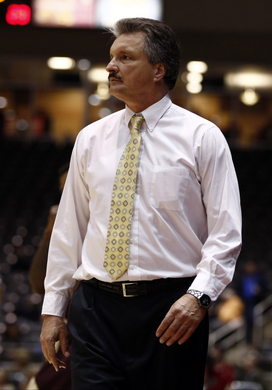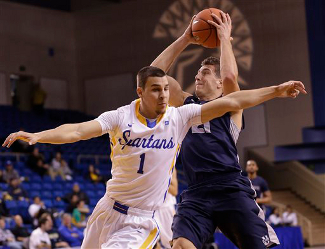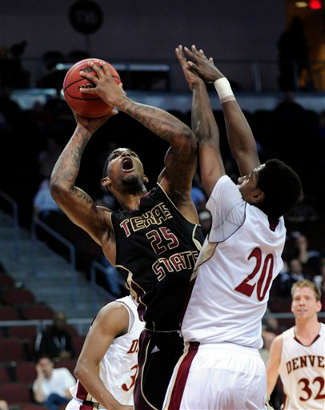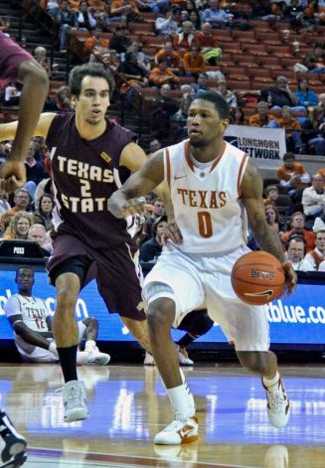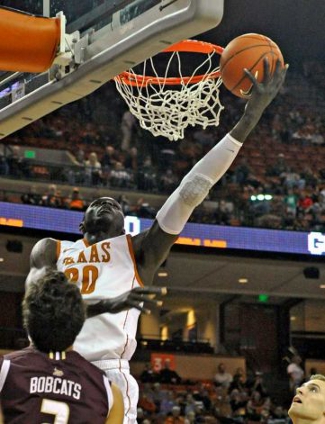Texas State Bobcats (6-2) at Texas Longhorns (6-2)
Frank Erwin Center | Austin, TX | Tip: 7 P.M. CT | TV: Longhorn Network
LRT Consecutive Game #195
The Texas Longhorns are back in action tonight as they renew their annual rivalry with nearby Texas State at the Frank Erwin Center. This is the 46th all-time meeting on the hardwood between these two schools, and this marks the eighth-straight year they have squared off. Texas has defeated Texas State a whopping 40 out of 45 times, with their last defeat coming all the way back in the 1937-38 season.
The Longhorns looked good in their last outing, riding the hot hand of freshman Sheldon McClellan to an 18-point win over UT-Arlington. Texas had five players in double-digit scoring and sank more than 48% of their shots from the field in the victory. Fans can look forward to even more offense tonight as the Longhorns squeeze in another tune-up before tougher non-conference tests at the end of the month.
By the numbers
Once again, Texas State is one of the fastest five teams in the country, an honor the team has held in each of Coach Doug Davalos’ first five seasons in San Marcos. The Bobcats actually played at the fastest tempo in all of Division-I basketball during the 2007-08 season, averaging more than 80 possessions per game. Although that number is incredible in its own right, it’s even more ridiculous that the Longhorns and Bobcats have averaged 81.2 possessions in their five match-ups since Davalos took over.
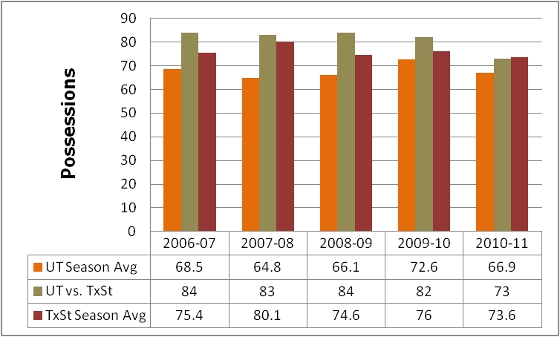 Last year, the Bobcats had a hard time scoring the ball. This year, their offense has improved slightly, but now their defense is one of the absolute worst in the country. Texas State is allowing 1.094 points per possession, a number that only puts them ahead of 16 other D-I schools in that department.
The Bobcats have one of the 25 worst free-throw rates in D-I, allowing their opponents one free throw for every two field goal attempts. Of course, they are also allowing opponents to knock down 40% of their threes and almost 45% of their shots, so perhaps allowing other teams to beat them one point at a time might not seem so bad in comparison.
Texas fans will like the fact that Texas State is one of the worst offensive rebounding teams in the country. The Longhorns have been equally bad on the defensive glass, so the rebounding battle on that end of the floor will be interesting. One would think that the bigger Texas frontcourt would be able to exploit their size advantage, but that hasn’t been the case so far this season against smaller teams.
Those poor offensive rebounding numbers are really killing the Bobcat offense, which is actually shooting at a 47% clip and is making 40% of their threes. Texas State is also controlling the ball very well, turning it over on just 16.6% of their possessions. That number is just outside of the Top 20 nationally, but it is even more remarkable when you remember just how fast they play the game. If Texas State could actually reclaim some of their missed shots, the offense would be incredibly efficient.
Meet the Bobcats
As is the case every year, Coach Davalos has a very deep bench that he uses liberally to keep fresh legs on the court. Nine different Bobcats average more than 14 minutes a game, with another four players on the bench averaging between seven and nine. If this game is played at the breakneck speed of the last five meetings, there is no doubt that the smaller Longhorn rotation is going to be gassed down the stretch.
Although the Bobcats have a true ensemble cast, the one word that best describes the team is young. Texas State lost five of the top six scorers from last year’s team, meaning that just 35.3% of the team’s scoring returned this season. While the Longhorns are certainly in a similar situation, the newcomers on the Texas State sideline are just a tad less heralded than those Rick Barnes has brought on board.
Last year, the Bobcats had a hard time scoring the ball. This year, their offense has improved slightly, but now their defense is one of the absolute worst in the country. Texas State is allowing 1.094 points per possession, a number that only puts them ahead of 16 other D-I schools in that department.
The Bobcats have one of the 25 worst free-throw rates in D-I, allowing their opponents one free throw for every two field goal attempts. Of course, they are also allowing opponents to knock down 40% of their threes and almost 45% of their shots, so perhaps allowing other teams to beat them one point at a time might not seem so bad in comparison.
Texas fans will like the fact that Texas State is one of the worst offensive rebounding teams in the country. The Longhorns have been equally bad on the defensive glass, so the rebounding battle on that end of the floor will be interesting. One would think that the bigger Texas frontcourt would be able to exploit their size advantage, but that hasn’t been the case so far this season against smaller teams.
Those poor offensive rebounding numbers are really killing the Bobcat offense, which is actually shooting at a 47% clip and is making 40% of their threes. Texas State is also controlling the ball very well, turning it over on just 16.6% of their possessions. That number is just outside of the Top 20 nationally, but it is even more remarkable when you remember just how fast they play the game. If Texas State could actually reclaim some of their missed shots, the offense would be incredibly efficient.
Meet the Bobcats
As is the case every year, Coach Davalos has a very deep bench that he uses liberally to keep fresh legs on the court. Nine different Bobcats average more than 14 minutes a game, with another four players on the bench averaging between seven and nine. If this game is played at the breakneck speed of the last five meetings, there is no doubt that the smaller Longhorn rotation is going to be gassed down the stretch.
Although the Bobcats have a true ensemble cast, the one word that best describes the team is young. Texas State lost five of the top six scorers from last year’s team, meaning that just 35.3% of the team’s scoring returned this season. While the Longhorns are certainly in a similar situation, the newcomers on the Texas State sideline are just a tad less heralded than those Rick Barnes has brought on board.
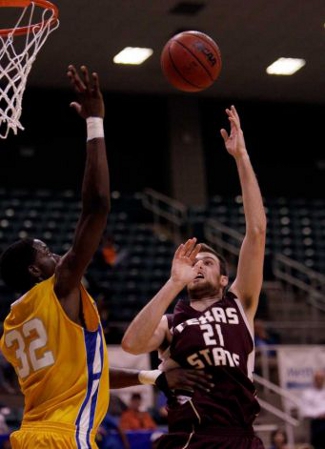
Matt Staff is Texas State’s leading scorer this season
(Photo credit: Bob Levey/San Antonio Express-News) |








